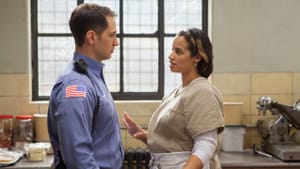Stay in the Loop
BSR publishes on a weekly schedule, with an email newsletter every Wednesday and Thursday morning. There’s no paywall, and subscribing is always free.
When your choices don’t matter: The terror and appeal of 'Orange Is the New Black'
'Orange Is the New Black' Season Two (second review)

Netflix’s Orange Is the New Black is officially out of control. Time reports that people are doing more than obsessing about the show on social media around the clock: They’re starting a new fashion trend by wearing orange jumpsuits out in public.
The sheriff of Saginaw County, Michigan isn’t pleased because inmates of the county jail sometimes work outside the facility, and now he’s worried that girls going to the mall in orange jumpsuits will be mistaken for prisoners — or that one of his inmates will stroll off without getting a second look, blending right in with the local OITNB fanatics. Saginaw County inmates are now wearing good old-fashioned black-and-white stripes (no word yet on whether women following that execrable Beetlejuice pants fad are now being mistaken for Saginaw County inmates).
BSR editor Judy Weightman did a great job of introducing the show last month, once she reappeared after watching all 13 episodes of Season Two in a single day — a feat made possible when Netflix enabled TV bingers across the globe by releasing them all on June 6.
I second Judy’s admiration of the show’s complex characters, but unlike Judy, I don’t think the show’s underlying theme is the choices we make.
Not the masters of our fate
A series of nightmarish scenarios, including a plumbing fiasco, a Sandy-like hurricane that strands inmates in the cafeteria, the denial of lifesaving healthcare to a cancer patient, a cop in league with a drug dealer, a mistaken stabbing victim, and an elderly inmate with dementia released to wander the streets alone, emphasize a world without an underlying order — a world where individuals’ choices don’t make much difference, and the characters struggle to survive anyway.
As Season Two episodes unfold the backstories of characters like Crazy Eyes, Taystee, and Poussey, viewers get an intimate look at the women’s origins, but rarely do we know the details of the crime that landed them in prison — and that information seems increasingly irrelevant.
Many of the non-incarcerated characters, including the flagrantly embezzling assistant warden Natalie Figueroa and male prison staffers who abuse their power by having sex with the inmates, sexually harassing them, or bringing in contraband, are committing as many illegal acts as the inmates themselves. This underscores the sense of a world adrift. Even the central story of the privileged Piper Chapman’s incarceration for agreeing to shuttle her girlfriend’s drug money seems like a random twist of fate rather than a bad decision. It took the justice system a decade to pursue Piper, and then someone much more deeply implicated in the crime is released before Piper is. In OITNB, whether or not you’re in prison isn’t a matter of self-determination, but whether or not you’ve been unlucky enough to run afoul of a dysfunctional system in a life where we’re all at least a little bit bad.
Look out, Shakespeare
In a world without reliable or fair moral and social ballasts, OITNB’s real theme comes to the fore, grounding its wild success in a basic human dynamic that everyone instinctively understands: the fight for status within the world we’re given. Other TV shows and films trade in comedy, intricate supernatural quandaries, the suspense and titillation of romance, or the rush of good guys fighting the bad. But OITNB is so compelling because it resists formulaic plotting in favor of tracing the ebb and flow of power between individuals and groups, when love is always an instant away from revenge.
This often violent ballet of shifting power includes the crafty Russian kitchen maven, Red, and her white “family” versus the queenly but sociopathic Vee and her black compatriots, the Spanish girls’ leverage over a prison guard who’s gotten one of them pregnant, and other authority struggles.
It all spawns dialogue full of insults whose brash, hilarious eloquence might be worthy of a 21st-century Globe Theater.
When a rift among the prison’s rough, wan meth addicts leads the lank-haired Leanne to accuse the sharp-eyed Pennsatucky of being “some Hillary Clinton dictator,” episode six writer Stephen Falk and Taryn Manning’s Pennsatucky unleash what is perhaps TV’s best takedown of the year, hammering home the women’s lack of agency in their own lives:
“Y’all must be some sister-wife tweaker Slurpee-drinkin’ fourth-grade-readin’-level daddy-on-Cops trailer-trash nothin’!”
Enough doctors and vampires
The show’s focus on power dynamics inside an otherwise absurd, painful, and unpredictable system is probably what resonates so deeply with millions of fans, who are also living in a world of capricious disasters, uncertain rights, social upheaval, and the need to prove ourselves afresh each day in the public forum. It’s an approach that allows for a diversity that’s unheard-of in the TV world: scary, funny, and sympathetic characters of almost every race and size, young and old, straight, lesbian, bisexual, and transgender. Instead of glamorous 20- and 30-somethings playing gossipy lovers, brilliant doctors, teen vampires, or glee club singers, OITNB, for all the volatility of the stories it tells, is a microcosm of the diverse, unpredictable world as we actually see and know it.
No wonder folks are so enamored of the show that they’re buying orange jumpsuits. I’ll stick to my jeans, but I can’t wait for Season Three.
What, When, Where
Orange Is the New Black, Season Two. Created by Jenji Kohan. Based on the novel by Piper Kerman. Available for streaming on Netflix.
Sign up for our newsletter
All of the week's new articles, all in one place. Sign up for the free weekly BSR newsletters, and don't miss a conversation.
 Alaina Johns
Alaina Johns